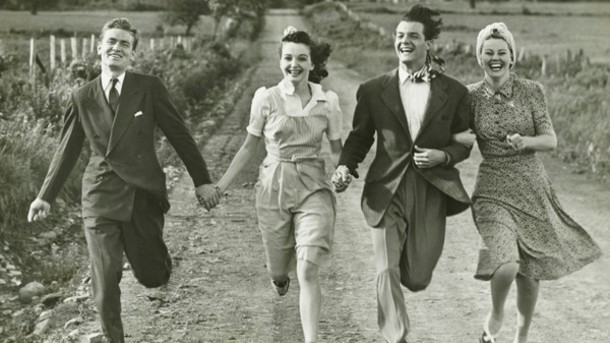Does Your Historic Site Communicate a Subliminal 'Make American Great Again' Message?
Above: A familiar scene: the spinning wheel demo. Sturbridge Village
(photo by Rickpilot_2000, Flickr)
'Spinning' The Story
As I wander through historic sites, I often think about the underlying message that is being communicated to visitors through exhibits and programming. Consider the following scenario: a woman at a spinning wheel teaches a group of children about the tedious process of carding, dying, spinning, and weaving cotton fibers. So what’s the take-away? That we should be lucky to live today in a convenient era when our clothing is made in far-away factories and sold to us cheaply? Or how about a different spinning wheel scenario – one in which the docent explains that spinning, weaving, and the whole process requires skills that have become almost extinct. “Sadly,” she explains, “we’ve lost touch with the know-how that our ancestors had and now the culture is lost.” The message is now about an idealized era.
I prefer to think about these underlying messages as questions rather than answers :
“essential questions”
(a term made ubiquitous in K-12 classrooms around 2005 with the publication of Understanding by Design).
An essential question is one that endures through the ages, keeps us curious, and has no correct answer.
When I first heard Trump’s campaign slogan “Make America Great Again,” I was reminded of an essential question I’ve been chewing on since I began studying history:
Are things getting better or worse?
(Art by Chris Piascik)
I realize that my question is ridiculously general. Better in what way? For whom? But it’s still a useful frame, given the broad Trump slogan. We can suppose that almost half of our country’s population thinks that things are getting worse. They have overtly positive feelings – nostalgia -- for certain aspects of American life that no longer exist. Does your historic site reinforce or challenge those notions?
History can be presented as a nice warm blanket of nostalgia, a graveyard of irrelevance, or as messy and challenging as current day life. I suspect most sites offer a patchwork quilt of all of the above, but are these the messages you intend to communicate to your visitors? How is your site subliminally answering this question, through its exhibits and programs?
Studies show nostalgia has positive pyschological effects
Fun fact: the term “nostalgia” was coined in 1688 by a Swiss medical student studying the effects of war on mercenary soldiers. The condition was actually considered a weakness and classified as a mental disorder. Soldiers’ positive feelings for the past were making them dissatisfied with the present. They were forbidden from singing Swiss songs around the campfire, so they didn’t become too distracted and depressed to focus on the mission at hand.
Today nostalgia is considered a natural and normal part of life that can often have psychological benefits. Studies conducted by University of Southhampton researchers over a decade show that we are more likely to dwell on positive stories in our past rather than negative ones. Even painful memories are transformed in our brains to representmore positive outcomes like building character, perseverance, or sticking together. Nostalgia has been clinically shown to “counteract loneliness, boredom and anxiety.” Tapping into these positive feelings can even make people physically warmer in a cold room. Next time you’re shivering or depressed, just reminisce about that time you met your significant other or that year you won the spelling bee.
We cling to the past when the present is difficult
Perhaps not surprisingly, nostalgic feelings are highly correlated with eras in history when there are rapid societal changes (Wheeler 2016). Could this be why we have history museums in the first place – to help us deal with the loss and fear that comes with change? And the threats that modernity poses? German historian Tobias Becker has written extensively on what he calls the “Nostalgia Wave” of the 1970s and 1980s. He theorizes that the explosion in the number of historic sites can be attributed to a boom in nostalgia in the 1970s. He correlates this wave with an upheaval of social norms in the 1960s and a struggling economy. Pretty interesting, ehh? I always thought the '76 bicentennial inspired the founding of so many historical sites in the 1970s, but Becker's nostalgia theory seems very plausible.
(Check out his blog: Homesick for Yesterday)
The positive neurological effects of nostalgia could also explain why Trump’s slogan is so successful. He offers people a kind of brain medicine. And perhaps they needed this prescription due to high levels of dissatisfaction with their current circumstances. The more disgruntled people are, the more they reminisce about the “good old days.”
My Ah-ha moment with the power of nostalgia
Tapping into nostalgia can be a powerful tool for museums. I have always loved those moments when an object triggers nostalgia in an older person, which then starts a family conversation. But I don’t think I truly understood the emotional “zinger” this can give your brain until last fall when I visited the Henry Ford Museum in Dearborn, Michigan.
Perhaps until recently, nothing from my childhood was old enough to put in a museum. But now that I am old and crusty, I get to have these blissful moments. In an exhibit at the Ford called “Your Place in Time” there was a simple timeline of popular objects by decade. I drifted through 1910 – 1970 without much reaction, but then I hit nostalgia pay dirt. In a prominently placed display case in the 1980s section was the Atari 2600 with a Pac-Man game cartridge!
A huge smile came over my face. Standing there all-alone, I looked around for someone to talk to about it – no luck. Oh, the many hours I spent back in the early 80s gobbling up primitive-looking dashes and box-shaped “vitamins” (which I insisted on calling “fruits” to be more faithful to the arcade version of the game). If someone was standing next to me I would have bragged about the blisters I got from the joystick. (I’m getting excited even as I type this). Seeing the Atari console was like a portal to the positive parts of my childhood.
If you played Atari Pac-man, check out the video above for a big nostalgia buzz!
Negatives of Nostalgia
So what’s the harm in tapping into nostalgia if it makes people feel good? Well, like any drug, nostalgia can cover-up real issues and stunt our ability to adapt to the present. We can and certainly should learn from the past, but since we tend to remember mostly positive aspects of life, relying on nostalgia can over-simply those lessons. It is easy to perpetuate the myth that a historic version of life is somehow more real or more authentic than life today.
Historian Stephanie Coontz (and author of the excellent book The Way We Never Were) calls this fallacy of over-simplifying and over-romanticizing the past “The Nostalgia Trap.” Coontz’s career has been dedicated to warning people of the “dangers of imagining a Golden Age in the past that we should try to recapture.” She advocates that we dissect the myths of the good old days by looking at eras through many lenses and perspectives.
For example, what do the 1950s look like through the lens of:
- Women's rights?
- Wages for manufacturing jobs?
- Divorce rate?
- African American access to quality education?
- Number of Americans going to church regularly?
- Rights and access for individuals with disabilities?
You could pick any of these lenses to argue the “getting better or worse” question. And either one (or both) would be correct depending on your individual experience and opinions.
How can history museums avoid the Nostalgia Trap?
As Coontz suggests, presenting a more complex version of history is one way to prevent nostalgia from having ill effects.
Even though we may remember history fondly, there were other narratives at work. The Atari game system I geeked out about actually cost my parents $200 in 1982. This is the equivalent of $500 today – not cheap. So there were millions of parents who couldn’t afford to buy this kind of luxury for their kids. Other people my age don’t have this memory. This perspective would be an interesting and more inclusive addition.
Another way to complicate my Pac-Man memory is to look at the rise of female gamers. In a 2010 interview, the male creator of the arcade version of Pac-Man said he created this game to appeal to women. He said he didn’t think women would want to play violent games, and imagined that they might like a game about eating. (Wow, ok) But to his credit, there was a significant uptick in female gamers after Pac-Man became popular. This lens places my object of nostalgia in a messier more interesting frame.
Another tactic is to provide purposeful bridges from past to present and to fully illuminate the trajectory of changes.
This means showing that history is not static; it’s continually unfolding. Pac-man may have inspired girls to play video games back in the 1980s, but today there is significant amount of controversy related to sexism in gaming (lack of non-sexual female characters) and sexual harassment of female game designers (#gamergate). Despite the fact that women make up half of gamers today, the video game sphere is still a male-dominated power structure. But this story is still unfolding. What will happen next?
“history that calls attention to the process rather than permanence may . . . help us to be more prepared for future change.”
(Anticipatory History, DeSiley, Naylor, Sacket 2011)
We are always “doing” history and it is never done. Making this fact more transparent to visitors may allow nostalgia to serve as an identity touchstone -- one that is connected to the present and future.
Dr. Rebecca Wheeler interviewed 27 residents of a small English town about how they use nostalgia to see the present day. She uses the term “productive nostalgia” to describe the way in which some people use the history of a place to provide a sense of continuity that can help them cope with change. Yes, some people do this naturally. But for those who don’t, history museums have the unique ability to explicitly frame history’s stories within the larger context of present day issues.
Using essential questions is an excellent way to do this.
Examples of essential questions that can connect time periods:
- How should we balance personal freedom with the security of the masses?
- How does where we live influence who we are?
- To what extent should humans interfere with nature?
Today we are in the midst of era of immense societal and technological change. Research tells us that people will rely on nostalgia to be an anchor in the storm.
So it is our job as history museum professionals to give them that anchor, but to also:
Complicate the past by including multiple perspectives.
Use the power of nostalgic objects and topics to lure visitors into deeper analysis.
Make direct connections from past to present.
Present history as a series of essential questions that leave visitors continually processing the past and future together.
Take a critical look at the underlying messages that exhibits and programs communicate about the trajectory of history.







